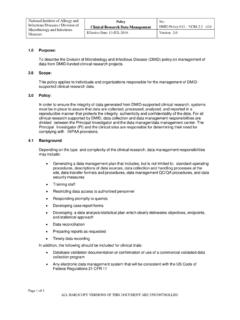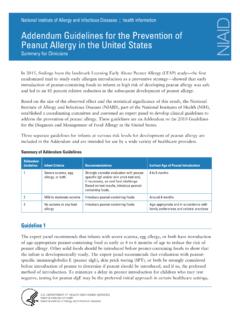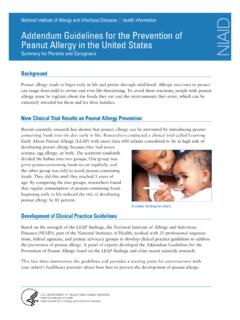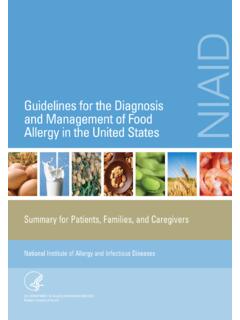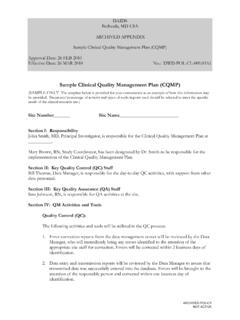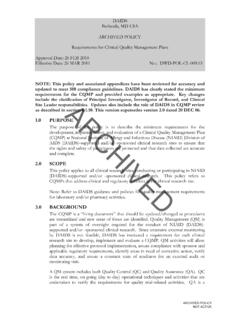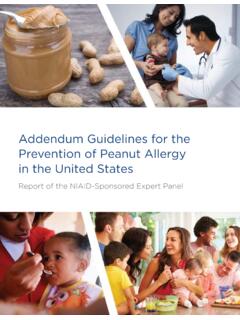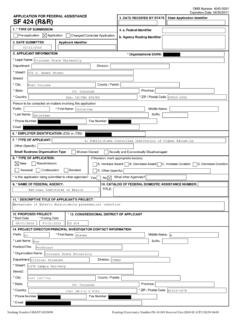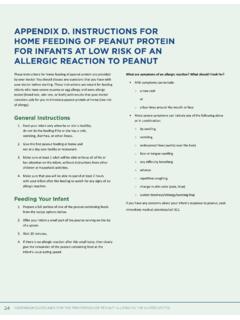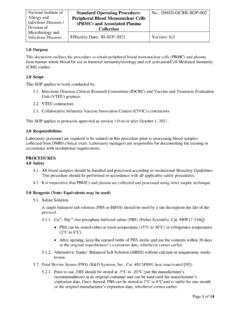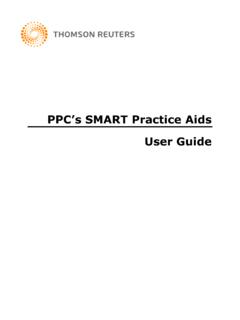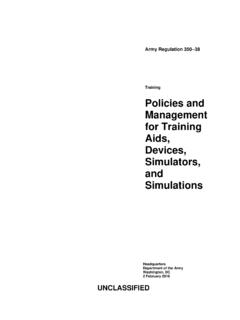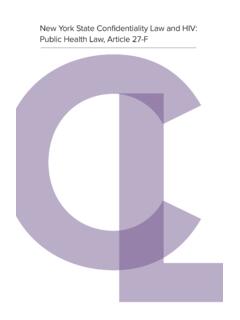Transcription of Effective Date: 09/28/19 Document No.: MAN-A-OD-001
1 DAIDS Guidelines for Good Clinical Laboratory Practice Standards Public Health Serv ices national Institutes of Health Bethesda, Mary land 20892 Site Principal Investigator and Laboratory Director: All national Institutes of Health, national institute of allergy and infectious Diseases, Division of aids - supported clinical trials involving human subjects must ensure compliance with f ederal regulations including procedures to protect the safety of all participants. These studies must be conducted in a manner to assure the sponsor a nd regulatory agencies that all data submitted are a true reflection of the results obtained during a study and that this data can be relied upon when making risk and/or safety assessments of study products. DAIDS has dete rmined that Good Clinical Laboratory Practices (GCLP) a re the minimal requirements that clinical research laboratories should follow, as GCLP embraces b oth the research/pre- clinical and clinical aspects of Good Laboratory Practices (GLP).
2 Comply ing with GCLP is an ongoing process that is ce ntral to optimal clinical research laboratory operation s. DAIDS will monitor the progress toward GCLP compliance through annual audits a nd/or site visits for most laboratories. GCLP compliance will ensure that consis tent, reproducible, auditable, and reliable laboratory results that support clinical trials will be produced in an environment conducive to study reconstruction. To support the many laboratories that conduct quality laboratory testing for clinical trials around the world, DAIDS has developed, in collaboration with PPD, t he attached DAI DS Guidelines for Good Clinical Laboratory Practices (GCLP) Standards. This g uidance Document is provided to clearly define the standards that encompass GCLP to include applicable portions of 21 Code of Federal Regulations (CFR) part 58, or GLP, and 42 CFR part 493, or Clinical Laboratory Improvement Amendment (CLIA) rul es.
3 Due to the ambiguity of some parts of these regulations, the attached Document also includes guidance from accrediting b odies such as the College of American Pathologists and South African national Accreditation System. These GCLP standards should be applied to all laboratories performing testing that supports a clinical trial sponsored by DAIDS. Institutions must also meet sponsor-specific requirements as outlined in the Sponsor Statement of thi s Document . The first 37 pages of the Document provide the GCLP standards. The next 66 pages a re appendices that offer additional information and guide lines on how to implement some of these standards. This do cument can also be accessed on the DAIDS Clinical Research Policies and Standard Procedures Documents a s an appendix to the Laboratory policies for Requirements for DAIDS Funded and/or Sponsored Laboratories in Clinical Tr ia ls ( esources/DAIDSClinRsrch/ ).
4 I hope these GCLP standards become a useful resource for your clinical research labo ratory operations. This Document has been vetted through the DAIDS Management Group, Regulatory Affairs Branch, Office of Policy for Clinical Research Operations, DAIDS Clinical Laboratory Oversight Team (DCLOT), and the Cross Network Laboratory Groups. If you have any questions about the content of thi s Document please contact your Network Coordi nator or the DAIDS Clinical Lab Oversight Team (DCLOT s e-mail: ). Sincer ely, Carl W. Dieffenbach, Director, Division of aids , NIAID, NIH DAIDS Guidelines for Good Clinical Laboratory Practice Standards The devel opment of these GCLP standards was a collaborative e ffort between PPD and the Division of aids (DAIDS). The authors that have contributed to this Document are listed below: PPD, Inc.: DAIDS: Global Government and Public Health Services, Laboratory DAIDS Clinical Laboratory Oversight Team The authors would also like to thank the following groups for their review and comments: Network Laboratory Groups Patient Safety Monitoring in International Laboratories ( pSMILE) Development of t his d ocument was funded by the HIV Clinical Research Support Contract Number N01-AI-50022 Good Clinical Laboratory Practice Standards Final Version , 09 July 2 013 i Table of Contents Table of Contents.
5 I1. Sponsor Statement .. 1 Introduction .. 1 Food and Drug Administration s Form FDA 1572 .. 1 Study Plans and Analytical Plans ..2 Enrollment in External Quality Assurance Programs .. 2 Retention of Records .. 2 Performance Specifications Validation of Test Methods .. 2 Good Clinical Laboratory Practices .. 32. Introduction .. 33. Organization and Personnel ..4 A. Introduction to Organization and Personnel ..4 B. Standards for Organization and Personnel .. 4 Documentation .. 4 Staff Education and Evaluations .. 5 Staff Numbers .. 6 Staff Identification .. 6C. Record Retention .. 64. Equipment .. 6A. Introduction to Equipment .. 6B. Standards for Equipment ..7 Documentation Guidelines ..7 General Guidelines .. 7 Service Guidelines .. 75. Testing Facility Operation .. 9A. Introduction to Testing Facility Operation .. 9B. Standards for Testing Facility Operation.
6 10 SOP Format .. 10 SOP Distribution .. 10 Document Control Plan .. 11 SOP Categories .. 1 1 C. Record Retention .. 1 2 Good Clinical Laboratory Practice Standards Final Version , 09 July 2 013 ii 6. Test and Control .. 12 A. Introduction to Test and Control .. 12 B. Standards for Test and Quality Control .. 12 Quality Control Program .. 12 Evaluation Criteria .. 12 Frequency of Quality Control Testing and Types of Control Materials .. 13 Review of Quality Control Data .. 14 Quality Control Logs .. 14 Corrective Action Logs .. 14 Supervisor Review of Quality Control Documentation .. 14 Quality Control Record Retention .. 15 Labeling and Storage of Quality Control Materials and Reagents .. 15 Inventory Control .. 1 6 Parallel Testing .. 16 Water Quality Testing .. 16 7. Verification of Performance Specifications .. 17 A. Introduction to Performance Specifications.
7 17 B. Standards for Performance Specifications .. 18 8. Records and Reports .. 22 A. Introduction to Records and Reports .. 22 B. Standards for Records and Reports .. 22 Record and R eport T racking .. 22 Record R etention .. 23 Data I ntegrity .. 23 Report F ormat .. 23 Pertinent R eference Ranges .. 24 Laboratory Assays and Performance S pecifications .. 24 Assay Results .. 24 Result M odification Log a nd Errors in T est R esults .. 25 Archiving R eports or R ecords .. 26 Good Clinical Laboratory Practice Standards Final Version , 09 July 2 013 iii 9. Physical Facilities .. 26A. Introduction to Physical Facilities .. 26B. Standards for Physical Facilities .. 26 General Space .. 26 Temperature and Humidity Controls .. 27 Cleanliness of Facilities .. 27 Archiving and Storage Spaces .. 27 Molecular Amplification Work Areas .. 27 10. Specimen Transport and Management.
8 27 A. Introduction to Specimen Transport a nd Management .. 27B. Standards for Specimen Transport and Management .. 27 Standard Operating Procedure .. 27 Specimen Labeling .. 28 Laboratory Testing Request Form (Requisition) .. 28 Specimen Acceptance/Rejection Criteria .. 28 Audit Trails and Chain-of-Custody .. 28 Specimen Transportation and Shipment .. 29 Specimen Preparation, Analysis and Retention .. 29 11. Personnel Safety ..30 A. Introduction to Personnel Safety .. 30B. Standards for P ersonnel Safety .. 30 Safety Equipment .. 30 Documentation .. 30 Evacuation Policy/Plan .. 31 Personal Protective Equipment (PPE) .. 31 Material Safety Data Sheets .. 31 Safety Policies .. 31 Safety Training .. 32 Safety Incident Reporting .. 33 12. Laboratory Information Systems .. 33 A. Introduction to Laboratory Information Systems .. 33 B. Standards for Laboratory Information Systems.
9 34 Laboratory Information System Validation .. 34 Generation of Reports .. 34 Good Clinical Laboratory Practice Standards Final Version , 09 July 2 013 iv Audit Trails .. 34 Access and Security .. 34 Documentation .. 35 Technical S upport and Preparedness .. 35 13. Quality Management .. 36 A. Introduction to Quality Management .. 36 B. Standards for Quality Management .. 36 Quality Management Plan .. 36 Internal Audits .. 37 Testing Turnaround Times .. 37 Laboratory Communication Plan .. 37C. Standards for External Quality Assurance .. 38 Version History .. 39 Glossary .. 41 References ..50 Appendix Descriptions .. 52 Appendix 1: Template of Study Plan for Specific Laboratory Endpoint Assay .. 60 Appendix 2: Training Attendance Log .. 65 Appendix 3: Example of Signature Sheet .. 66 Appendix 4: Example of SOP in CLSI Format .. 67 Appendix 5: L-J Chart Example.
10 78 Appendix 6: Quality Control Log Example .. 79 Appendix 7: Example of Reportable Range Experiment Results .. 80 Appendix 8: Example of Analytical Sensitivity Experiment Results .. 83 Appendix 9: Example of Precision Experiment Results .. 84 Appendix 10: Example of Analytical Specificity Experiment Results .. 87 Appendix 11: Example of Accuracy Experiment Results .. 88 Appendix 12: Example of Reference Range Experiment Results .. 92 Appendix 13: Example of Laboratory Test Method List .. 94 Appendix 14: Example of Quality Management Plan .. 102 Good Clinical Laboratory Practice Standards Final Version , 09 July 2 013 1 of 105 Good Clinical Laboratory Practices Standards 1. Sponsor Statement Introduction The mission of the Division of aids (DAIDS) of the national institute of allergy and infectious Diseases (NIAID), national Institutes of Health (NIH) is to help ensure an end to the HIV/ aids epidemic by increasing basic knowledge of the pathogenesis and transmission of HIV disease , supporting the discovery and development of therapies for HIV infection and its complications, and supporting the discovery and development of vaccines and other prevention strategies.
